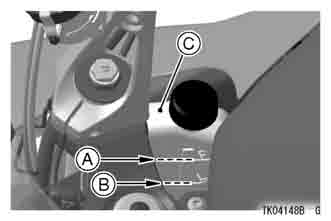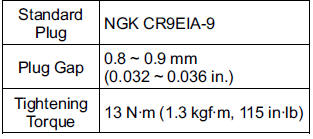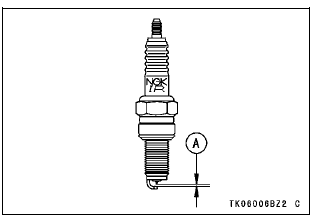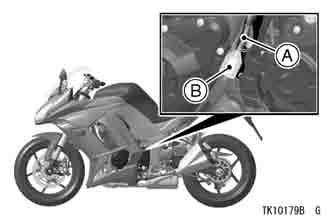 Kawasaki Z1000SX - Owner's Manual > Cooling System
Kawasaki Z1000SX - Owner's Manual > Cooling System
Radiator and Cooling Fan
Check the radiator fins for obstruction by insects or mud. Clean off any obstructions with a stream of low-pressure water.
WARNING The cooling fan spins at high speed and can cause serious injuries.
Keep your hands and clothing away from the cooling fan blades at all times.
NOTICE Using high-pressure water, as from a car wash facility, could damage the radiator fins and impair the radiator's effectiveness.
Do not obstruct or deflect airflow through the radiator by installing unauthorized accessories in front of the radiator or behind the cooling fan. Interference with the radiator airflow can lead to overheating and consequent engine damage.
Radiator Hoses
Check the radiator hoses for leakage, cracks or deterioration, and connections for leakage, or looseness each day before riding the motorcycle, and carry out the maintenance and adjustments in accordance with the Periodic Maintenance Chart.
Coolant
Coolant absorbs excessive heat from the engine and transfers it to the air at the radiator. If the coolant level becomes low, the engine overheats and may suffer severe damage. Check the coolant level each day before riding the motorcycle, also carry out the maintenance and adjustments in accordance with the periodic maintenance chart. Replenish coolant if the level is low. Change the coolant in accordance with the Periodic Maintenance Chart.
Information for Coolant
To protect the cooling system (consisting of the aluminum engine and radiator) from rust and corrosion, the use of corrosion and rust inhibitor chemicals in the coolant is essential. If coolant containing corrosion and rust inhibitor chemicals are not used, over a period of time, the cooling system accumulates rust and scale in the water jacket and radiator. This will clog up the coolant passages, and considerably reduce the efficiency of the cooling system.
WARNING Coolant containing corrosion inhitors for alminum engines and radiators include harmful chemicals for human body.
Drinking coolant can result in serious injury or death. Use coolant in accordance with the instractions of the manufacturer.
Soft or distilled water must be used with the antifreeze (see below for antifreeze) in the cooling system.
NOTICE If hard water is used in the system, it causes scale accumulation in the water passages, and considerably reduces the efficiency of the cooling system.
If the lowest ambient temperature encountered falls below the freezing point of water, use permanent antifreeze in the coolant to protect the cooling system against engine and radiator freeze-up, as well as from rust and corrosion.
Use a permanent type of antifreeze (soft water and ethylene glycol plus corrosion and rust inhibitor chemicals for aluminum engines and radiators) in the cooling system. On the mixture ratio of coolant, choose the suitable one referring to the relation between freezing point and strength directed on the container.
NOTICE Permanent types of antifreeze on the market have anti-corrosion and anti-rust properties. When it is diluted excessively, it loses its anti-corrosion property. Dilute a permanent type of antifreeze in accordance with the instructions of the manufacturer.
NOTE
- A permanent type of antifreeze is installed in the cooling system when shipped. It is colored green and contains ethylene glycol. It is mixed at 50% and has the freezing point of - 35ºC (-31ºF).
Coolant Level Inspection
- Situate the motorcycle so that it is perpendicular to the ground.
- Check the coolant level if it is between the F (Full) and L (Low) level lines.
NOTE
- Check the level when the engine is cold (room or atmospheric temperature).

- F (Full) Level Line
- L (Low) Level Line
- Reserver Tank
- If the amount of coolant is insufficient, remove the right fairing and add coolant into the reserve tank.
Coolant Filling
- Remove the cap from the reserve tank and add coolant through the filler opening to the F (Full) level line.

- Reserve Tank
- F (Full) Level Line
- L (Low) Level Line
- Cap
- Install the cap.
NOTE
- In an emergency you can add water alone to the coolant reserve tank, however it must be returned to the correct mixture ratio by the addition of antifreeze concentrate as soon as possible.
NOTICE If coolant must be added often, or the reserve tank completely runs dry, there is probably leakage in the system. Have the cooling system inspected by your authorized Kawasaki dealer.
Coolant Change
Have the coolant changed by an authorized Kawasaki dealer.
Spark Plugs
The standard spark plug is shown in the table. The spark plugs should be replaced in accordance with the Periodic Maintenance Chart.
Spark plug removal should be done by an authorized Kawasaki dealer.
Spark Plug


- 0.8 ~ 0.9 mm (0.032 ~ 0.036 in.)
Valve Clearance
Valve and valve seat wear decreases valve clearance, upsetting valve timing.
NOTICE If valve clearance is left unadjusted, wear will eventually cause the valves to remain partly open; which lowers performance, burns the valves and valve seats, and may cause serious engine damage.
Valve clearance for each valve should be checked and adjusted in accordance with the Periodic Maintenance Chart.
Inspection and adjustment should be done by an authorized Kawasaki dealer.
Kawasaki Clean Air System
The Kawasaki Clean Air System (KCA) is a secondary air suction system that helps the exhaust gases to burn more completely. When the spent fuel charge is released into the exhaust system, it is still hot enough to burn.
The KCA System allows extra air into the exhaust system so that the spent fuel charge can continue to burn. This continued burning action tends to burn up a great deal of the normally unburned gases, as well as changing a significant portion of the carbon monoxide into carbon dioxide.
Air Suction Valves
The air suction valve is essentially a check valve which allows fresh air to flow only from the air cleaner into the exhaust port. Any air that has passed the air suction valve is prevented from returning. Inspect the air suction valves in accordance with the Periodic Maintenance Chart. Also, inspect the air suction valves whenever stable idling cannot be obtained, engine power is greatly reduced, or there are abnormal engine noises.
Air suction valve removal and inspection should be done by an authorized Kawasaki dealer.
Exhaust Device
This motorcycle is equipped with a exhaust device system. This system controls the valve in the exhaust pipe and produces stable engine power at low and middle engine speed. This exhaust device is controlled by the ECU, and adjustment or maintenance should be done by an authorized Kawasaki dealer.

- Exhaust Device Cables
NOTICE Do not adjust the exhaust device system by yourself. The maladjustment will cause the poor engine performance and engine damage.
Air Cleaner
A clogged air cleaner restricts the engine's air intake, increasing fuel consumption, reducing engine power, and causing spark plug fouling.
This motorcycle's air cleaner element consists of a wet paper filter, which cannot be cleaned.
The air cleaner element must be replaced in accordance with the Periodic Maintenance Chart. In dusty, rainy, or muddy conditions, the air cleaner element should be serviced more frequently than the recommended interval.
Removal and cleaning should be done by an authorized Kawasaki dealer.
Oil Draining
- Inspect the transparent reservoir located on the left side of the engine to see if any oil or water has run down from the air cleaner housing.

- Drain Hose
- Reservoir
- If there is any oil in the reservoir, remove the reservoir and drain the oil.
WARNING Oil on tires will make them slippery and can cause an accident and injury. Be sure to install the reservoir in the drain hose after draining.
See also:
 Kawasaki Z1000SX - Owner's Manual > Periodic Maintenance Chart, Engine Oil
Kawasaki Z1000SX - Owner's Manual > Periodic Maintenance Chart, Engine Oil
The maintenance and adjustments outlined in this chapter must be carried out in accordance with the Periodic Maintenance Chart to keep the motorcycle in good running condition. The initial maintenance is vitally important and must not be neglected.
 Kawasaki Z1000SX - Owner's Manual > Throttle Control System
Kawasaki Z1000SX - Owner's Manual > Throttle Control System
Check the throttle grip play each day before riding the motorcycle, and carry out maintenance and adjustments in accordance with the Periodic Maintenance Chart. Adjust it if necessary. Throttle Grip
 Rider's Manual BMW R 1250 GS GSA
Rider's Manual BMW R 1250 GS GSA Owner's Manual Harley-Davidson Sportster XL1200X Forty-Eight
Owner's Manual Harley-Davidson Sportster XL1200X Forty-Eight Owner's Manual Honda CBR650R
Owner's Manual Honda CBR650R Service manual Honda CBR650
Service manual Honda CBR650 Owner's Manual Honda PCX125
Owner's Manual Honda PCX125 Owner's Manual Kawasaki Z1000SX
Owner's Manual Kawasaki Z1000SX Service manual Kawasaki Z1000SX
Service manual Kawasaki Z1000SX Owner's Manual Lexmoto Echo
Owner's Manual Lexmoto Echo Owner's Manual Royal Enfield Interceptor 650
Owner's Manual Royal Enfield Interceptor 650 Service manual Royal Enfield Interceptor 650
Service manual Royal Enfield Interceptor 650 Owner's Manual Yamaha MT-07
Owner's Manual Yamaha MT-07